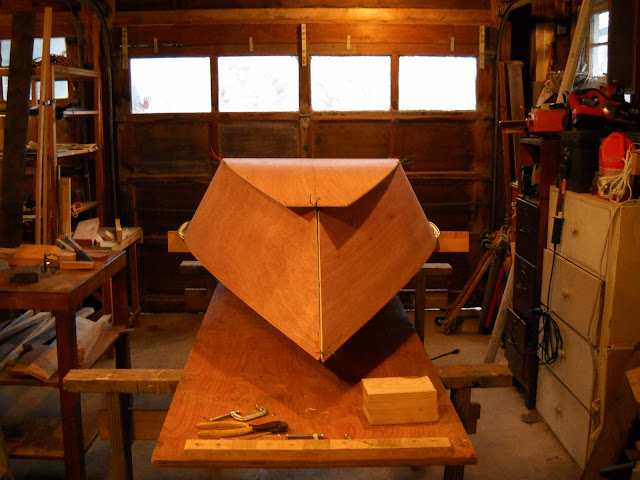Cold in the shop today, but the wood stove, and the occasional nip from the flask, kept things moving along.
 |
| Even with the wood stove going the shop is still only in the 40's. |
While trying to get the transom on the bow to line up I decided to see what the boat would look like with a pointed bow.
 |
| Much more traditional looking |
So I took the transom bow out and brought the side together. I temporarily fastened the sides together
and flipped the boat over.
 |
| I like the angle of the bow, but don't think I couldn't keep it if I added length to the bottom. |
The rocker brings the bow up pretty high, but I don't think too much so. The concern I have with this is that I would loose the slightest bit of surface area on the bottom, even so, I probably need every bit of buoyancy that I can eek out of this single sheet of plywood.
 |
| temporary midship frame. |
 |
| The beam is 2' at the bottom amidship, 3' at the gunwale. |
I did like the more traditional look of the pointy stem. I put a one and a half inch square piece in at the stem to check the angle the sides come into. The 90 degree corner seemed to work just fine! The only bevel needed would be where the stem meets the floor. A 35 degree setting on the chop saw worked pretty well at a guess.
 |
| The stern is almost to vertical for my tastes, but I think it has just enough rake to keep it from looking just like a box |
I suppose I could try the boat with this hull shape. I could even lengthen the bottom a few inches, up to a total length of 7'6" and still have enough left over for the transom. The stem would be close to plumb and that might not look as nice. I might try it. At $13.99 for the sheet of plywood, why not? All the other wood used for framing, gunwales, chines.....is scrap.
 |
| with the transom bow I think the boat has a asian quality to it. |
I put the transom bow back in, but with the angles to work out for the sides I am loosing about 2 or 3 inches in over all length.
 |
| looking at the stem, boat upside down, with this angle the boat will loose a few inches of LOA, but only 1/4 in of length on the bottom. |
If I do try to build a pointy version I might try to make another chine in the bottom at the bows with a cut and twist into shape technique, so that the bow will cut thru the water easier.









